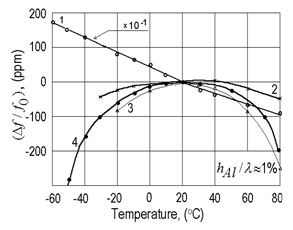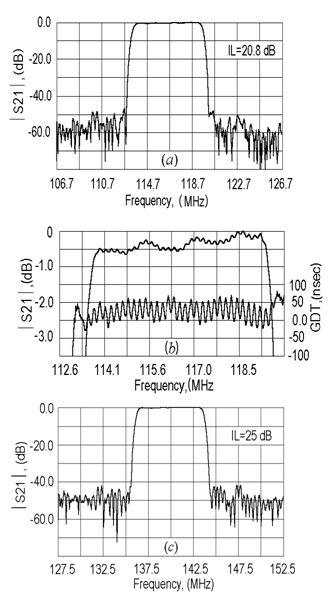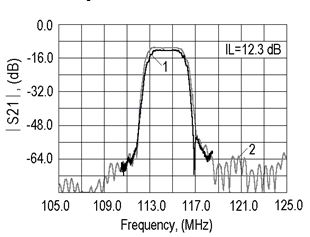Due to good temperature stability and moderately high electromechanical coupling coefficient langasite (Li3Ga5SiO4 or LGS) is known as a promising material for SAW devices. The characteristics of the Rayleigh wave propagation on LGS have been studied fairly well. However, no design of SAW devices on LGS suitable for modern communication systems has been reported as yet. In this paper, transversal filters on LGS based on bidirectional interdigital transducers, and low-loss filters on LGS based on natural single phase unidirectional transducers (NSPUDT), are described. The filters on LGS have exhibited better electrical parameters than their analogues on quartz and lithium tantalate.
The substrate material for SAW devices must satisfy a number of requirements, such as high electromechanical coupling coefficient , good temperature stability (the best temperature coefficient of delay is TDC=0), small power flow angle (the best is=0o), low level of parasitic modes which determines the selectivity of a device in a wide frequency band (not less than =-(50-55) dB). To avoid diffraction distortions, it is also desirable that the propagation direction of SAW should coincide with direction, where the anisotropy parameter = -1. None of widely used crystallographic orientations in known materials (quartz, lithium tantalate, lithium niobate) meets all these requirements. Therefore, the search for, and study of, new materials and their cuts is an important task.
Recently the family of temperature stable LGS cuts with the Euler angles 15о<<10o; 120o<<165o; 20o<<45o has been found [1]. In addition to TCD»0 ppm, some of these cuts exhibit high piezoelectric coupling (=0.28-0.38), low PFA (½½<2o) and anisotropy parameter close to the optimal value »-1. Later the natural unidirectionality of SAW generation has been discovered for some cuts in this family [2]. One more advantage of the LGS cuts indicated is the low level of parasitic modes. It is =-(50-55) dB in a wide frequency band, being 30 dB and 20 dB less than for YX and ZY cuts of LGS, respectively [3], and 5 dB less than for (90o,90o,112o) lithium tantalate cut. Since the effective velocity of SAW on LGS is low, =2400-2600 m/s, the size of devices on LGS can be reduced at least by 20-30 % as compared with that of their analogues on quartz and lithium tantalate. So, because of the above listed properties langasite is a promising substrate material for SAW filters with good electrical parameters.
In this paper, we report the results of the study of transversal filters, based on bidirectional interdigital transducer, and low-loss filters, based on NSPUDT with stepped electrodes. The filters of the first and second types are for use in relay lines of communication systems and radiotelephones of W-CDMA standard, respectively. As a substrate material, the [0o,140o,25o] cut Li3Ga5SiO4 is utilized in both the types of filters. This cut is close to the optimal one. Besides, it has been chosen for study because the phase shift between the mechanical and electrical components of SAW in NSPUDT is known, =-51° [2].
The parameters of SAW propagating on LGS were computed in [1,2,5]. However, these computations have yielded different results, since the different sets of elastic and temperature constants were used. So, we had to experimentally determine some of the important characteristics of [0o,140o,25o] cut LGS in order to provide an adequate accuracy in designing SAW filters on this cut.
By the method resembling the one described in [4], we have measured the SAW velocity on the free () and the metallized () surfaces, the electromechanical coupling coefficient , the temperature coefficients of delay (TCD) of the first () and the second () orders, and the dielectric permittivity . Table 1 summarizes the results of measurements for the case of the aluminum film of thickness »1 %. They agree well with the data obtained in [1]. For comparison the analogous characteristics for (0°,140°,22.5°) cut LGS [5] are also given in Table 1.
| Characteristic | SiO2 | LGS | |
| (0o,132.75o,0o) | (0o,140o,22.5o) | (0o,140o,25o) | |
| Vaf, m/s | 3157 | 2742.1 | 2736 |
| K^2 | 0.14 | 0.32 | 0.38 |
| a2*108/oC2 | - 3.2 | - 7.8 | - 6.8 |
| Tt, oC | 25 | 25 | 23 |
| e | 4.92 | - | 27 |
| , degr. | 0 | 52 | 51 |
Fig.1 shows the temperature dependence of the central frequency shift of the filters fabricated on the substrates made of different materials at »1 %. For the lithium tantalate, the scale /oC is used. The temperature stability of the filter on the (0o,140o,25o) cut LGS is seen to be substantially better than that of the filter on the (90o,90o,112o) cut lithium tantalate and practically the same as that of the (0o,132.75o,0o) cut quartz. The temperature dependence of the central frequency shift for the filter on the (0o,140o,25o) LGS cut is described accurately enough in a wide temperature range by the parabola , where is the temperature deviation from the turnover temperature . For the 1% thick aluminum electrodes and metallization ratio =0.5, we have obtained the first order TCD » 0 and the second order TCD » ‑6.8Ч10-8 (1/oC)2 and =23o.

Fig.1. Temperature dependence of the center frequency of SAW filters: 1 - LiTaO3, cut (90o,90o,112o), (*f/f0)*10-5/oC; 2 - SiO2, cut (0o,132.75o,0o); 3 - LGS, cut (0o,140o,22.5o); 4 – LGS, cut (0o,140o,25o)
For design of transversal filters with small amplitude and phase passband ripples as well as of SPUDT based low-loss filters, the reflection coefficient from an electrode is an important parameter. Referred to the centre of a strip of thickness , this coefficient becomes [11]
where is the metallization ratio, is the number of electrodes per wavelength in IDT, , , are the coefficients determining the contribution of piezoelectric effect, mechanical loading, and energy storage effect, respectively. In contrast to quartz, the storage effect is the predominant mechanism of the reflection in LGS. At =0.00143; =0.047, and =0.28 the above formula describes the experimental values of the reflection coefficient from the aluminum electrode on the [0o,140o,25o] LGS cut with a good accuracy.
In addition to the temperature stability, the low shape factor SH=1.1-1.2, selectivity larger than UR=50 dB, and ripples of group delay time at most GDT<50 ns are also important requirements of transversal filters for relay line.
To achieve such parameters, we have designed the 117 MHz filter with the bandwidth BW3=7.36 MHz (5.2%), and SH(40/3)=1.12 on (0o,140o,25o) cut LGS. The filter uses the input apodized and output withdrawal weighted transducers. The aperture of both the transducers is =1.8 mm or 50. The IDT’s use split-finger electrodes to ensure the bidirectionality on NSPUDT substrate. The electrode thickness is =2500 Ao. The chip dimensions are 15.0 x 3.0 x 0.5 mm. The frequency dependences ofЅS21Ѕand GDT for the filter under the condition of matching with the impedances of the source and load =50 Ohm are shown in fig. 2a,b. In this case matched insertion loss is IL=20.5 dB at ripples GDT=50 ns. Ultimate rejection in stop-band equals UR=50-55 dB.
For comparison, using the same mask, we have fabricated a filter on (90o,90o,112o) LiTaO3 cut. The filter has not been specially optimized but the electrode thickness has been reduced to =2000 Ao in order to decrease the reflection coefficient. Fig.2c shows the frequency dependences of ЅS21Ѕ and GDT for this filter. The central frequency has increased up to 140 MHz, or by 17 %, which corresponds to the SAW velocity on LiTaO3=3290 m/s. In the filter on LiTaO3 matched insertion loss (IL=25.2 dB) is larger by 4.5-5 dB at the same ripples GDT=50 ns and ultimate rejection (UR=45 dB) is worse by 5-8 dB as compared with the filter on LGS.

Fig.2. Comparison of measured frequency responses of transversal filters: (a) – LGS, cut (0o,140o,25o) in wide band; (b) – LGS, cut (0o,140o,25o) in passband; (c) - LiTaO3, cut (90o,90o,112o)
The first effect can be attributed to better matching conditions for the filter on LGS, because the dielectric permittivity of the substrate (»27) is less approximately by the factor of 2. The second effect can be explained by weaker influence of diffraction (»-1) in the vicinity of the passband and lower level of parasitic modes (»55-60 dB) in the far stopband [3].
To summarize, the parameters of transversal filters on LGS with the bandwidth BW3=3-6 % are better than that of the filters on LiTaO3. In addition, the chip dimensions can be decreased by 15-20 %, since the SAW velocity in LGS is lower than in LiTaO3 .
Natural single phase unidirectional transducers (NSPUDTs) are the most elegant solution among numerous alternatives of unidirectional transducers for low-loss filters. The unidirectionality of NSPUDT is achieved by ±/8 shift between the transduction and reflection centers due to electrode reflection of transducer and asymmetry of the crystal [6]. In designing NSPUDT low-loss filters, the basic challenge is how to make reversal transducers having the opposite directivity relative the direct NSPUDT with two /4 electrodes per wavelength [6]. Among reversal NSPUDT structures the most preferable are the configurations fabricated using a single stage technological process with a single operation of metallization. Such configurations of Reversal Directivity Transducer or RDT have recently been described in [7]: Electrode Width Difference (EWD) type RDT, Transduction Center Shift (TCS) type RDT, Group-type RDT.
In the filters on [0o,140o,25o] cut LGS, we used the SAW propagating along the X+25 o direction. In this case the phase shift between the electrical potential and the mechanical displacement of the reflected SAW is =-51o [2]. This phase angle was used as a parameter in the simulation technique based on equivalent circuit model. As reversal transducers, we used modified TCS-types RDT and Group-type RDT.
In order to increase the efficiency of SAW generation in TCS-type RDT we have introduced a shorted reflected electrode. This has eliminated the negative effect of the charges induced on the isolated reflected electrode [7]. The width of the shorted electrode and its location with respect to excited electrodes in the new TST-type RDT have been optimized to obtain the maximum reflection and better directivity at =-51o. The minimum size of the electrodes was .
To improve the shape factor and selectivity, the direct and reversal NSPUDT have been divided along the aperture into several parallel acoustic channels. Similar channels of the direct and reversal NSPUDT formed the subfilter with the central frequency corresponding to the period of electrodes in -th channel. Such transducers have stepped electrodes with weighted electrode period and aperture of channels (WEPAC). The WEPAC transducers operate similarly to the tapered SPUDT [9].
They can be called "quasi-slanted" transducers [8]. The WEPAC transducers, however, do not use slanted electrodes. The electrode period and aperture in neighbour channels have been weighted to improve the shape-factor and to increase ultimate rejection. To adjust the phase ripples of the filter in total, the subfilters have been shifted relative to each other in the direction of SAW propagation.
Fig.3 shows the frequency dependences of and phase for the W-CDMA 240 MHz filter on [0o,140o,25o] LGS cut. The filter uses the direct WEPAC NSPUDT with the /4 electrodes and the reversal WEPAC NSPUDT (first modified TCS-type). Each of the transducers has been divided into 10 channels. The length of each channel was 125 in the direct NSPUDT and 197 in the reversal one. The chip dimensions were 5.5 x 2.0 x 0.5 mm. The 9.0 x 7.0 x 1.5 mm SMD package was utilized. The filter was matched with the impedances =50 Ohm. Insertion loss did not exceed IL=10.8 dB. Ultimate rejection was more than 55 dB in the frequency range ±100 MHz.
For comparison we have designed the analogous W-CDMA 230 MHz filter, which uses two WEPAC bidirectional transducers on the (0o,132.75o,0o) quartz cut. The matched with 50 Ohm insertion loss and ultimate rejection of the filter are IL=16.6 dB and UR=50 dB in the frequency range =±100 MHz, respectively. The chip dimensions are 7.0 x 3.0 x 0.5 mm. The 9.0 x 7.0 x 1.5 mm SMD package is utilized.
Thus, as compared to filters on quartz, the low-loss filters on LGS exhibit lower insertion loss, improved selectivity, and smaller dimensions with nearly the same temperature stability.
Fig.4 shows experimental and calculated dependences ofЅS21Ѕ for the filter that uses alternative modification of the reversal WEPAC NSPUDT on LGS. The main parameters of the filter are: =115 MHz, BW3=3.2 MHz or 2.8%; IL=12.3 dB on 50 Ohm system, UR=50 dB, phase ripples RMS=2.4o. The calculated values agree well with the experimental results.

Fig.4. Measured (1) and calculated (2) frequency responses of 115 MHz filter with reversal WEPAC NSPUDT, TST type 2
As is known, SAW propagation loss for radio frequencies of 1.2-2.4 GHz is small in LGS. However, the low SAW velocity, being an advantage at intermediate frequencies, complicates the fabrication of filters for the radio frequencies, since the electrode size must then be small.
To overcome this obstacle, the high frequency Group-type unidirectional transducer [10] has been changed to the reversal NSPUDT. The minimum size of electrodes and period of sections in this transducer were /6 and , respectively. In fig. 5 the frequency dependences ofЅS21Ѕ for the W-CDMA filter with the central frequency =250 MHz and bandwidth BW3=5.2 MHz or 2.1 % are shown. Like in the previous cases, the filter uses the direct WEPAC NSPUDT with electrodes. The reversal WEPAC NSPUDT is, however, of the Group-type with /6 electrodes. Within the frequency range ±2.4 MHz the ripples are GDT=90 ns and phase ripples are RMS=3o. Matched insertion loss has increased up to IL=12.1 dB as compared to the 230 MHz filter, because the excitation efficiency of the Group-type NSPUDT is lower [10]. Nevertheless, this filter on [0o,140o,25o] LGS cut also exhibits a high selectivity UR=50 dB in the band ±15 MHz and UR=70 dB in a wide band of 50-500 MHz.

Fig.5. Measured frequency responses of 250 MHz W-CDMA filter with reversal NSPUDT Group-type: (a) – in wide band;
(b) – in passband.
This paper reports the practical results of the designing SAW filters on langasite. The transversal filters on LGS with passbands of 2-6% based on bidirectional transducers are shown to exhibit better electrical parameters and temperature stability than the filters on LiTaO3. The low-loss filters on LGS that use the new reversal NSPUDT's with the shifted center of transduction and the reversal Group-type NSPUDT possess lower insertion loss and better selectivity than the filters on quartz. Thus, we have demonstrated that LGS cut with temperature stable characteristics is a very promising substrate material for high performance SAW devices for communication systems.